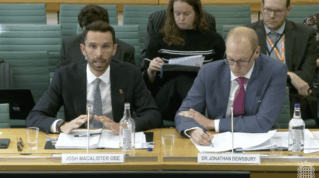Unions have called on the government to urgently invest in restoring school buildings – as a “damning” new report revealed a £13.8bn backlog in maintenance.
The new National Audit Office (NAO) report, published today, estimates a maintenance backlog of at least £49bn across key public services including schools, prisons, hospitals, and MOD sites.
Almost 30 per cent of this backlog – £13.bn (28 per cent) – was accounted for by schools, which came in joint-second place with NHS sites, behind only MoD properties.
The NAO added that “poor government data” means the true cost “cannot be estimated” and “is likely to be higher”.
Paul Whiteman, general secretary at school leaders’ union NAHT, described the report as “damning”, and said the new government must “go further and faster” in making school buildings safe and fit for purpose.
“We frequently hear from school leaders of the unacceptable conditions with which pupils and staff are having to contend – from crumbly concrete to leaking roofs, draughty portable cabins and school dinners being served in corridors,” said Whiteman.
School and college buildings ‘neglected’
“The funding announced in the autumn Budget was a welcome start, but the Treasury admitted it would only get the existing inadequate 10-year rebuilding programme, which is only supposed to benefit around 50 schools a year, back on track.

“The true cost of restoring crumbling school buildings is now likely to be far greater than the £13.8m cited here, and it’s vital that the ongoing national condition survey is completed without delay so the government has a more accurate picture of the funding needed.”
He said setting out a major long-term school rebuilding programme should be a top priority for government investment in the spring spending review.
Meanwhile Julia Harnden, Funding Specialist at the Association of School and College Leaders (ASCL), said the NAO report “lays bare the scale of government neglect of the school and college estate”.
“Recent government investment looks tiny compared with the cuts that have taken place over the last 15 years and the level of need this has inevitably created down the line,” said Harnden.
“We agree with the NAO’s recommendations and particularly the need for the Department for Education to set out an ambitious, long-term plan of how it will ensure school and college buildings are fit for the future, but we also need the Treasury to support the plan with investment. Short-term thinking and small-scale investment is just not going to cut it.”
Building condition can affect retention
Maintenance covers all interventions that help keep buildings up to standard – including cleaning, checking walls and roofs, and repairing and replacing electric, water, sewage, and heating systems.
Well-maintained properties “are more cost effective, less likely to break down, more valuable and longer lasting than poorly maintained buildings”, says the NAO.
The Cabinet Office estimates that deferring backlog maintenance work can increase costs by more than 50 per cent over a two to four-year period.
Working in well-maintained buildings can come with “higher levels of wellbeing, reduced absenteeism and higher productivity”, says public spending watchdog the NAO.
Meanwhile, it found poor property condition can have a negative effect on staff retention – a key issue affecting the teacher workforce.
‘Historic under-investment’ a key factor
The NAO said the government’s maintenance backlog “has increased steadily in recent years”, to the current £49bn estimate.
It cited several reasons behind the rise, including historic under-investment, cost increases and inflationary pressures, and many buildings reaching the end of their intended operational lift at the same time.
The £49bn backlog equates to around four per cent of the government’s total expenditure in 2023-24, or around £710 for each person living in the UK.
Meanwhile the actual cost of remediation – improving the condition of property, rather than just maintaining it – could be “substantially higher, in some cases 10 times higher”, says the Office of Government Property (OGP).
The £13.8bn backlog relating to schools is based on DfE estimates, based on data collected between 2017 and 2019, “converted to 2023-34 prices”.
It does not account for investment made, or improvements that have been carried out since then.
To address the backlog, the government is working to improve its understanding of the condition of its estate.
The OGP is introducing InSite, an enhanced data collection system, and aims to have implemented it by March 2025.
String of recommendations made by NAO
“The government needs to implement a range of measures to urgently address poor maintenance,” said the NAO.
The watchdog has made a string of recommendations, including mandating government departments and arms-length bodies to use a standardised definition of the maintenance backlog, so the true figure across government can be calculated.
It also said departments should produce long-term property plans, setting out capital needs and a plan to reduce their backlog.
It also recommended the Treasury should consider agreeing longer-term settlements for property investment and ring-fencing maintenance funding.
Gareth Davies, head of the NAO said: “Allowing large maintenance backlogs to build up at the buildings used to deliver essential public services is a false economy.
“Government needs better data on the condition of its operational assets and should use it to plan efficient maintenance programmes to deliver better services and value for money”.
The DfE has been approached for comment.















Your thoughts